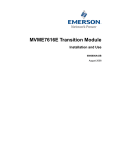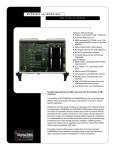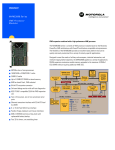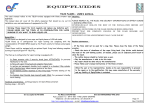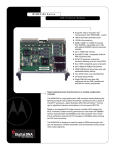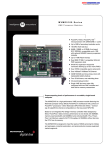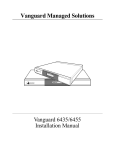Download MVME761-001
Transcript
MVME761 Transition Module Installation and Use VME761A/IH4 November 19, 1999 Notice While reasonable efforts have been made to assure the accuracy of this document, Motorola, Inc. assumes no liability resulting from any omissions in this document, or from the use of the information obtained therein. Motorola reserves the right to revise this document and to make changes from time to time in the content hereof without obligation of Motorola to notify any person of such revision or changes. Electronic versions of this material may be read online, downloaded for personal use, or referenced in another document as a URL to the Motorola Computer Group website. The text itself may not be published commercially in print or electronic form, edited, translated, or otherwise altered without the permission of Motorola, Inc. It is possible that this publication may contain reference to or information about Motorola products (machines and programs), programming, or services that are not available in your country. Such references or information must not be construed to mean that Motorola intends to announce such Motorola products, programming, or services in your country. Restricted Rights Legend If the documentation contained herein is supplied, directly or indirectly, to the U.S. Government, the following notice shall apply unless otherwise agreed to in writing by Motorola, Inc. Use, duplication, or disclosure by the Government is subject to restrictions as set forth in subparagraph (b)(3) of the Rights in Technical Data clause at DFARS 252.227-7013 (Nov. 1995) and of the Rights in Noncommercial Computer Software and Documentation clause at DFARS 252.227-7014 (Jun. 1995). Motorola, Inc. Computer Group 2900 South Diablo Way Tempe, Arizona 85282 Preface MVME761 Transition Module Installation and Use provides general information, hardware preparation, installation instructions and support information for the MVME761-001 and MVME761-011 Transition Modules. The MVME761-0x1 Transition Module is used as the interface between the following host VMEmodules and various peripheral devices: ! CAUTION MVME2603-1121 to 1161 MVME2700-1421 to 1461 MVME2603-3121 to 3161 MVME2700-3221 to 3261 MVME2604-1321 to 1361 MVME2700-3321 to 3361 MVME2604-3321 to 3371 MVME2700-3421 to 3461 MVME2700-1221 to 1261 MVME3604-5342 to 5372 MVME2700-1321 to 1361 MVME4604-5342 to 5372 An MVME2600/MVME2700/MVME3600/MVME4600 module that is designed for use with an MVME712M Transition Module will be damaged if you use it with an MVME761-0x1 Transition Module. This manual is intended for anyone who wants to design OEM systems, supply additional capability to an existing compatible system, or for use in a lab environment for experimental purposes. A basic knowledge of computers and digital logic is assumed. To use this manual you should be familiar with the publications listed in the following section. Motorola Computer Group Documents The Motorola publications listed below are referenced in this manual. You can obtain paper or electronic copies of Motorola Computer Group publications by: ❏ Contacting your local Motorola sales office ❏ Visiting Motorola Computer Group’s World Wide Web literature site, http://www.mcg.mot.com/literature. Document Title Motorola Publication Number MVME2600 Single Board Computer Installation and Use V2600A/IH MVME2700 Single Board Computer Installation and Use V2700A/IH MVME3600/4600 Series VME Processor Module Installation and Use V36V46A/IH MVME3600/4600 Series VME Processor Module Programmer’s V36V46A/PG Reference Guide To obtain the most up-to-date product information in PDF or HTML format, visit http://www.mcg.mot.com/literature. Summary of Changes Change Date Description 11/19/99 Corrected transition module cable part numbers in Table 1-5. Updated Motorola Computer Group Document listing. 5/14/99 Updated VME board model numbers in Preface and General Description sections. 5/14/99 Added pinout information for P2 adapter cards. Table 4-8 and Table 4-11. 5/14/99 Updated Related Documentation table. 4/9/99 Corrected transition module cable part numbers in Table 1-5. 4/9/99 Added VME4600 board support 4/9/99 Updated all port 3 and 4 configuration drawings Safety Summary Safety Depends On You The following general safety precautions must be observed during all phases of operation, service, and repair of this equipment. Failure to comply with these precautions or with specific warnings elsewhere in this manual violates safety standards of design, manufacture, and intended use of the equipment. Motorola, Inc. assumes no liability for the customer’s failure to comply with these requirements. The safety precautions listed below represent warnings of certain dangers of which Motorola is aware. You, as the user of the product, should follow these warnings and all other safety precautions necessary for the safe operation of the equipment in your operating environment. Ground the Instrument. To minimize shock hazard, the equipment chassis and enclosure must be connected to an electrical ground. The equipment is supplied with a three-conductor ac power cable. The power cable must be plugged into an approved three-contact electrical outlet. The power jack and mating plug of the power cable meet International Electrotechnical Commission (IEC) safety standards. Do Not Operate in an Explosive Atmosphere. Do not operate the equipment in the presence of flammable gases or fumes. Operation of any electrical equipment in such an environment constitutes a definite safety hazard. Keep Away From Live Circuits. Operating personnel must not remove equipment covers. Only Factory Authorized Service Personnel or other qualified maintenance personnel may remove equipment covers for internal subassembly or component replacement or any internal adjustment. Do not replace components with power cable connected. Under certain conditions, dangerous voltages may exist even with the power cable removed. To avoid injuries, always disconnect power and discharge circuits before touching them. Do Not Service or Adjust Alone. Do not attempt internal service or adjustment unless another person capable of rendering first aid and resuscitation is present. Use Caution When Exposing or Handling the CRT. Breakage of the Cathode-Ray Tube (CRT) causes a high-velocity scattering of glass fragments (implosion). To prevent CRT implosion, avoid rough handling or jarring of the equipment. Handling of the CRT should be done only by qualified maintenance personnel using approved safety mask and gloves. Do Not Substitute Parts or Modify Equipment. Because of the danger of introducing additional hazards, do not install substitute parts or perform any unauthorized modification of the equipment. Contact your local Motorola representative for service and repair to ensure that safety features are maintained. Dangerous Procedure Warnings. Warnings, such as the example below, precede potentially dangerous procedures throughout this manual. Instructions contained in the warnings must be followed. You should also employ all other safety precautions which you deem necessary for the operation of the equipment in your operating environment. ! WARNING Dangerous voltages, capable of causing death, are present in this equipment. Use extreme caution when handling, testing, and adjusting. ! WARNING This equipment generates, uses, and can radiate electromagnetic energy. It may cause or be susceptible to electromagnetic interference (EMI) if not installed and used in a cabinet with adequate EMI protection. European Notice: Board products with the CE marking comply with the EMC Directive (89/336/EEC). Compliance with this directive implies conformity to the following European Norms: EN55022 (CISPR 22) Radio Frequency Interference EN50082-1 (IEC801-2, IEC801-3, IEEC801-4) Electromagnetic Immunity The product also fulfills EN60950 (product safety) which is essentially the requirement for the Low Voltage Directive (73/23/EEC). This board product was tested in a representative system to show compliance with the above mentioned requirements. A proper installation in a CE-marked system will maintain the required EMC/safety performance. Motorola® and the Motorola symbol are registered trademarks of Motorola, Inc. All other products mentioned in this document are trademarks or registered trademarks of their respective holders. © Copyright Motorola 1998, 1999 All Rights Reserved Printed in the United States of America Contents CHAPTER 1 General Information Introduction................................................................................................................1-1 Product Overview.......................................................................................................1-1 Features ......................................................................................................................1-1 General Description ...................................................................................................1-2 Serial Port Interface Modules ....................................................................................1-4 P2 Adapter Boards .....................................................................................................1-5 Three-row P2 adapter (MVME761-001) ............................................................1-5 Five-Row P2 adapter (MVME761-011) .............................................................1-6 Connectors and Cables...............................................................................................1-7 Specifications .............................................................................................................1-9 Cooling requirements..........................................................................................1-9 FCC compliance .................................................................................................1-9 CHAPTER 2 Hardware Preparation and Installation Introduction................................................................................................................2-1 Unpacking the Hardware ...........................................................................................2-1 Installing the Serial Interface Modules ......................................................................2-2 Installing the Transition Module and P2 Adapter ......................................................2-5 Procedure ............................................................................................................2-6 CHAPTER 3 Functional Description Introduction................................................................................................................3-1 Circuitry .....................................................................................................................3-1 P2 Signal Multiplexing (P2MX) ................................................................................3-4 Serial Interface Module Circuitry ..............................................................................3-7 Port Configuration Diagrams .....................................................................................3-8 COM1 and COM2 asynchronous serial ports.....................................................3-8 Asynchronous/Synchronous Serial Ports..........................................................3-10 vii CHAPTER 4 Connector Pin Assignments Introduction ............................................................................................................... 4-1 MVME761 Transition Module Connectors............................................................... 4-1 P2 connector ....................................................................................................... 4-1 Asynchronous serial port connectors (J5/J6)...................................................... 4-3 Asynchronous/Synchronous serial port connectors (J7/J8)................................ 4-4 Parallel I/O port connector (J4) .......................................................................... 4-6 Ethernet Connector (J9)...................................................................................... 4-7 P2 Adapter Connectors.............................................................................................. 4-8 3-Row P2 adapter (J2) ........................................................................................ 4-8 3-Row P2 adapter (J3) ........................................................................................ 4-9 5-Row P2 adapter (J1) ...................................................................................... 4-10 PMC I/O, 5-Row P2 adapter (J3) ..................................................................... 4-12 5-Row P2 adapter (J4) ...................................................................................... 4-13 viii List of Figures Figure 1-1. MVME761 transition module front panel and component side..............1-3 Figure 1-2. 3-row DIN backplane P2 adapter (MVME761-001)...............................1-5 Figure 1-3. 5-row DIN backplane P2 adapter (MVME761-011)...............................1-6 Figure 2-1. Serial port interface jumper settings........................................................2-2 Figure 2-2. Serial interface module and connector P1...............................................2-3 Figure 2-3. Installing a SIM onto the MVME761 transition module ........................2-4 Figure 2-4. MVME761-0x1 chassis connections.......................................................2-6 Figure 3-1. MVME761 transition module block diagram .........................................3-2 Figure 3-2. 3-Row DIN backplane P2 adapter block diagram...................................3-3 Figure 3-3. 5-Row DIN backplane P2 adapter block diagram...................................3-3 Figure 3-4. Multiplex signal timing chart ..................................................................3-6 Figure 3-5. EIA-574 DTE port configuration (COM1 and COM2) ..........................3-9 Figure 3-6. MVME761 EIA232 DCE configuration port 3.....................................3-11 Figure 3-7. MVME761 EIA232 DCE configuration port 4.....................................3-12 Figure 3-8. MVME761 EIA232-DTE configuration port 3.....................................3-13 Figure 3-9. MVME761 EIA232-DTE configuration port 4.....................................3-14 Figure 3-10. MVME761 EIA530-DCE configuration port 3 ..................................3-15 Figure 3-11. MVME761 EIA530-DCE configuration port 4 ..................................3-16 Figure 3-12. MVME761 EIA530-DTE configuration port 3...................................3-17 Figure 3-13. MVME761 EIA530-DTE configuration port 4...................................3-18 Figure 3-14. MVME761 V.35 DCE configuration port 3 ........................................3-19 Figure 3-15. MVME761 V.35 DCE configuration port 4 ........................................3-20 Figure 3-16. MVME761 V.35 DTE configuration port 3 ........................................3-21 Figure 3-17. MVME761 V.35 DTE configuration port 4 ........................................3-22 Figure 3-18. MVME761 X.21-DCE configuration port 3 .......................................3-23 Figure 3-19. VME761 X.21-DCE configuration port 4...........................................3-24 Figure 3-20. VME761 X.21-DTE configuration port 3 ...........................................3-25 Figure 3-21. VME761 X.21-DTE configuration port 4 ...........................................3-26 ix List of Tables Table 1-1. SIM part numbers .....................................................................................1-4 Table 1-2. MVME761 transition module connectors.................................................1-7 Table 1-3. 3-Row P2 adapter connectors (MVME761-001) ......................................1-7 Table 1-4. 5-Row P2 adapter connectors (MVME761-011) ......................................1-8 Table 1-5. MVME761 transition module cables ........................................................1-8 Table 1-6. MVME761-0x1 specifications ..................................................................1-9 Table 3-1. P2 signal multiplexing sequence...............................................................3-4 Table 4-1. MVME761 P2 connector pin assignments ...............................................4-1 Table 4-2. COM1 and COM2 pin assignments..........................................................4-3 Table 4-3. Serial port 3 pin assignments ....................................................................4-4 Table 4-4. Serial port 4 pin assignments ....................................................................4-4 Table 4-5. Parallel I/O connector pin assignments.....................................................4-6 Table 4-6. 10Base-T/100Base-TX pin assignments...................................................4-7 Table 4-7. 8-bit SCSI connector (3-Row P2 adapter) ................................................4-8 Table 4-8. VME connector (3-Row P2 adapter) ........................................................4-9 Table 4-9. 16-bit SCSI connector (5-Row P2 adapter) ............................................4-10 Table 4-10. PMC I/O connector (5-Row P2 adapter) ..............................................4-12 Table 4-11. VME connector (3-Row P2 adapter) ....................................................4-13 x 1General Information 1 Introduction This manual provides general information, hardware preparation, installation instructions, and a functional description for the MVME761-001 and MVME761-011 Transition Modules. Product Overview The MVME761-0x1 Transition Module provides the interface between the MVME260x, MVME270x, MVME360x, or MVME460x Single Board Computer VMEmodule and various peripheral devices. This module provides industry standard connectors to simplify customer cable requirements for the serial port, printer, and Ethernet signals. Features The features of the MVME761-0x1 Transition Module include: ❏ Industry-standard connectors for these interfaces: – Two EIA-574 asynchronous serial ports (DTE) – Two asynchronous/synchronous serial ports, which can be configured for EIA-232-D, EIA-530, V.35, or X.21 interfaces (DCE or DTE) – One parallel port (IEEE Standard 1284-I compliant) – 10Base-T/100Base-TX Ethernet ❏ Two 60-pin Serial Interface Module (SIM) connectors for configuring the asynchronous/synchronous serial ports ❏ Single-width board ❏ Electro-Magnetic Interference (EMI) and Electro-Static Discharge (ESD) protection 1-1 1 General Information General Description TheMVME761-0x1 Transition Module provides the interface between the standard Ethernet, parallel port, and the serial port connectors, and the following MVME260x, MVME270x, MVME360x, and MVME460x Single Board Computer VME modules: MVME2603-1121 to 1161 MVME2700-1421 to 1461 MVME2603-3121 to 3161 MVME2700-3221 to 3261 MVME2604-1321 to 1361 MVME2700-3321 to 3361 MVME2604-3321 to 3371 MVME2700-3421 to 3461 MVME2700-1221 to 1261 MVME3604-5342 to 5372 MVME2700-1321 to 1361 MVME4604-5342 to 5372 All port I/O controllers reside on the MVME260x, MVME270x, MVME360x, and MVME460x Single Board Computer modules. The MVME761 transition module Ethernet and parallel port circuitry is passive. The serial port circuitry provides multiplexing and buffering functions (refer to P2 Signal Multiplexing (P2MX) on page 3-4). The multiplexing function is transparent to the user. Both MVME761-0x1 models use the same transition module. The MVME761-001 comes with a P2 adapter that connects to a 3-row DIN chassis backplane. The MVME761-011 comes with a P2 adapter that connects to a 5-row DIN chassis backplane. Figure 1-1 shows the MVME761 transition module component layout and the front panel. See Table 1-2 for a list of the front panel port connectors. 1-2 Computer Group Literature Center Web Site General Description MVME 761-001 COM1 J5 COM2 J6 DTE 1 DCE J2 3 SERIAL 3 60 J1 59 2 1 J7 SERIAL 4 60 J12 59 2 1 J8 DTE DCE J3 1 3 PARALLEL J4 P2 10/100 BASET J9 1910 9609 Figure 1-1. MVME761 transition module front panel and component side http://www.mcg.mot.com/literature 1-3 1 1 General Information Serial Port Interface Modules You may configure the asynchronous/synchronous serial ports (ports 3 and 4) to the appropriate interface by installing a Serial Interface Module (SIM). A SIM is a small “plug-in” printed circuit board that converts the TTL-level synchronous or asynchronous port signals to industry standard voltage levels used by the ports. The SIM contains the receiver and transmitter circuits for converting the input and output signals of the host VMEmodule to the appropriate serial data communication protocol. The SIMs for the MVME761-0x1 are listed in the following table. Table 1-1. SIM part numbers Interface Model Number Part Number EIA-232-D DCE SIM232DCE 01-W3876B01B EIA-232-D DTE SIM232DTE 01-W3877B01A EIA-530 DCE SIM530DCE 01-W3878B01B EIA-530 DTE SIM530DTE 01-W3879B01B V.35 DCE SIMV35DCE 01-W3128F01A V.35 DTE SIMV35DTE 01-W3127F01A X.21 DCE SIMX21DCE 01-W3167F01B X.21 DTE SIMX21DTE 01-W3166F01A Note 1-4 Additional SIMs may be released. Please see your Motorola representative for a complete list of SIMS that are available for the MVME761-0x1. Computer Group Literature Center Web Site P2 Adapter Boards P2 Adapter Boards The P2 adapters route the asynchronous and synchronous port, printer port, and Ethernet signals to the MVME761 transition module. Three-row P2 adapter (MVME761-001) The P2 adapter for the MVME761-001 mounts onto a 3-row, 96-pin P2 backplane connector. The 50-pin male connector, J2, carries the 8-bit SCSI signals from the MVME260x, MVME270x, MVME360x, or MVME460x. To run SCSI devices, you may install an additional transition module that is equipped with a SCSI port, such as the MVME712B. 50 49 J2 2 1 J3 2 1 64 63 C1 1 J1 25 R1 9 C5 C6 C4 + 17 C3 C7 R2 U1 C 1 B A C2 CR1 U2 + 32 C B A P1 1933 9610 Figure 1-2. 3-row DIN backplane P2 adapter (MVME761-001) This P2 adapter, and the cable for connecting to the MVME761 transition module, can be ordered separately as model MVME761P2-001. http://www.mcg.mot.com/literature 1-5 1 1 General Information Five-Row P2 adapter (MVME761-011) The P2 adapter for the MVME761-011 mounts onto a 5-row, 160-pin P2 backplane connector. The 68- pin female connector, J1, carries 16-bit SCSI signals from the MVME260x, MVME270x, MVME360x, or MVME460x. It also has a 64-pin male connector, J3, for PMC I/O. J1 1 J3 33 2 1 64 63 2 1 64 63 J5 J4 1 25 1 U1 9 C8 + U2 17 U3 25 C9 9 R4 17 + 1 D C B A Z CR1 32 D C B A Z P1 1999 9701 Figure 1-3. 5-row DIN backplane P2 adapter (MVME761-011) This P2 adapter, and the cable for connecting to the MVME761 transition module, can be ordered separately as model MVME761P2-011. 1-6 Computer Group Literature Center Web Site Connectors and Cables Connectors and Cables The connectors on the MVME761 transition module and the P2 adapters are listed in the following tables. The port connectors are located on the front panel, which is shown in Figure 1-1. See Table 1-5 on page 1-8 for a list of the cables. See Chapter 4 for the connector pin assignments. The cable used for connecting the MVME761 transition module to the P2 adapter is provided with the MVME761-0x1. You will need to purchase or fabricate the port cables. Table 1-2. MVME761 transition module connectors Type Number Description COM1 and COM2 J5 J6 9-pin male DIN asynchronous serial port connector Serial port 3 Serial port 4 J7 J8 26-pin female HD-26 synchronous serial port connector Parallel port J4 36-pin female parallel port connector 10Base-T, 100Base-TX J9 8-pin female RJ-45 Ethernet port connector SIM J1, J12 60-pin female connector VME P2 64-pin male connector to J2 on the P2 adapter Table 1-3. 3-Row P2 adapter connectors (MVME761-001) Type Number Description VME P1 96-pin female DIN 41612 connector to the chassis backplane J3 64-pin male connector for output to P2 on the MVME761 transition module J2 50-pin male IDC connector for internal SCSI devices SCSI http://www.mcg.mot.com/literature 1-7 1 1 General Information Table 1-4. 5-Row P2 adapter connectors (MVME761-011) Type Number Description VME P1 160-pin female DIN 41612 connector to the chassis backplane J4 64-pin male connector for output to P2 on the MVME761 transition module PMC I/O J3 64-pin male connector for PMC I/O SCSI J1 68-pin female IDC connector for internal SCSI devices Table 1-5. MVME761 transition module cables Part Number Description Included with the MVME761-0x1 64-line flat ribbon cable with 96-pin DIN connectors that connects P2 on the MVME761 transition module to J3 on the 3-row P2 Adapter or J4 on the 5-row P2 adapter; 13 inches long. (30-W2799B02A). User-supplied EIA-232-D DTE or DCE cable (pins used depend on the processor VMEmodule) User-supplied Centronics- type parallel printer cable, male-to-male User-supplied 20-conductor cable; usually supplied with the modem User-supplied 6-conductor cable; usually supplied with the modem CBL761HD26DB25 Straight-through adapter cable with male HD-26 connector and female DB-25 connector, 3 feet long. (30-NW9302B27) Note 1-8 If you supply your own 64-line cable to connect the P2 adapter to the MVME761 transition module, the cable should not be longer than 1.5 feet. A longer cable is likely to cause problems, especially for the Ethernet and parallel port signals. Computer Group Literature Center Web Site Specifications Specifications The MVME761 transition module specifications are shown in Table 1-6. Table 1-6. MVME761-0x1 specifications Characteristics Specifications Power Requirements +12Vdc, 100mA typical, 200mA maximum -12Vdc, 100mA (for some of the SIMs) Operating temperature 0o to 55o C at chassis point of entry of forced air (approximately 5 CFM) Storage temperature -40o to +85o C Relative Humidity 5% to 90% (non-condensing) Board Size (excluding front panel) Height: 9.187 inches(233.35 mm) Height: 3.200 inches(80.00 mm) Thickness: 0.063 inches (1.60 mm) Cooling requirements The MVME761-0x1 is tested to operate under forced air cooling with an incoming air temperature range of 0 degrees C to 55 degrees C. Adequate cooling can be achieved with air flowing over the module at 5 cubic feet per minute. The exact amount of airflow required for cooling depends on the ambient air temperature and the type, number, and location of modules and other heat sources. FCC compliance The MVME761-0x1 was tested in an FCC-compliant chassis, and meets the requirements for Class A equipment. For minimum RF emissions, it is essential that you implement the following conditions: ❏ Install shielded cables on all external I/O ports ❏ Connect conductive chassis rails to earth ground to provide a path for connecting shields to earth ground ❏ Tighten all front panel screws http://www.mcg.mot.com/literature 1-9 1 2Hardware Preparation and Installation 2 Introduction This chapter provides unpacking instructions, hardware preparation, and installation instructions for the MVME761 transition module, the P2 adapter, and the Serial Interface Modules. Unpacking the Hardware Use ESD Wrist Strap The MVME761-0x1 is packed in an antistatic wrapper to protect it from static discharge. Motorola strongly recommends that you use an antistatic wrist strap and a conductive foam pad when handling the equipment. Electronic components can be extremely sensitive to electrostatic discharge (ESD). After removing the board from the protective wrapper, place it component side up on a grounded, static-free surface. Do not slide the board over any surface. Unpack the equipment from the shipping carton. Refer to the packing list and verify that all items are present. Save the packing material for storing and reshipping of the equipment. 2-1 Hardware Preparation and Installation 2 Installing the Serial Interface Modules Configure the serial ports 3 and 4 for the required interface by installing the appropriate SIM. See Table 1-1 on page 1-4 for a list of the serial port interface types. Prior to installing the SIMs, set the jumpers on header J2 (for serial port 3) and header J3 (for serial port 4) for either DCE or DTE. Set the jumper to position: ❏ 1-2 if the SIM is for a DTE interface ❏ 2-3 if the SIM is for a DCE 1 2 DTE 3 1 2 3 DCE 11650 9610 Figure 2-1. Serial port interface jumper settings Note You must set the jumpers and install the SIMs prior to installing the MVME761 transition module in the system chassis. The SIMs plug into connector J1 (for serial port 3) or J12 (for serial port 4) on the MVME761 transition module. Install the SIMs on the MVME761 transition module per the following procedure: 1. Align the SIM so that P1 on the SIM lines up with the appropriate SIM connector (J1 for serial port 3 or J12 for serial port 4) on the transition module. Note the position of the alignment key on P1. See Figure 2-2. 2-2 Computer Group Literature Center Web Site Installing the Serial Interface Modules 2 Mounting Hole P1 Alignment Key Mounting Hole 11637 9610 Figure 2-2. Serial interface module and connector P1 2. Place the SIM onto the transition module SIM connector, making sure that the mounting holes also line up with the standoffs on the transition module as shown in Figure 2-3. 3. Gently press the top of the SIM to seat it on the transition module SIM connector. If the SIM does not seat with gentle pressure, recheck the alignment of the connectors. Note Do not force the SIM onto the transition module. 4. Secure the SIM to the transition module standoffs with the two Phillips-head screws provided. Do not over tighten the screws. http://www.mcg.mot.com/literature 2-3 Hardware Preparation and Installation 2 1911 9609 Figure 2-3. Installing a SIM onto the MVME761 transition module 2-4 Computer Group Literature Center Web Site Installing the Transition Module and P2 Adapter Installing the Transition Module and P2 Adapter Install the MVME761 transition module and P2 adapter in the system chassis. The P2 adapter is required because the P2 connector on the transition module is not compatible with the P2 connector on the chassis backplane. Use ESD Wrist Strap Motorola strongly recommends that you use an antistatic wrist strap and a conductive foam pad when installing boards in a system chassis. Electronic components, such as disk drives, computer boards, and memory modules, can be extremely sensitive to ESD. Place the board flat on a grounded, static-free surface, component-side up. Do not slide the board over any surface. If an ESD station is not available, you can avoid damage resulting from ESD by attaching the ESD wrist strap to an unpainted metal part of the system chassis. Install the MVME761-0x1 in the system chassis per the Procedure on page 2-6. Refer to Figure 2-4, which shows the cabling and connections within the chassis. ! Caution ! An MVME2600/MVME2700/MVME3600/MVME4600 module that is designed for use with an MVME712M Transition Module will be damaged if you use it with an MVME761-0x1 Transition Module. Connecting modules while power is applied may result in damage to components on the module. Caution ! Warning Dangerous voltages, capable of causing death, are present in this equipment. use extreme caution when handling, testing, and adjusting. http://www.mcg.mot.com/literature 2-5 2 Hardware Preparation and Installation 2 VME BACKPLANE MVME260x/MVME360x MVME761 Transition Module P1 30-W2799B02A 64-CONDUCTOR CABLE P2 ADAPTER P2 P1 P2 J3 ON THE 3-ROW P2 ADAPTER J4 ON THE 5-ROW P2 ADAPTER ENCLOSURE BOUNDARY 11654.00 9610 Figure 2-4. MVME761-0x1 chassis connections Procedure 1. Turn all equipment power OFF and disconnect the power cable from the AC power source. 2. Remove the chassis cover per the instructions in the equipment user’s manual. 3. If the chassis has a rear card cage, remove the filler panel(s) from the appropriate card slot(s) at the rear of the chassis. 2-6 Computer Group Literature Center Web Site Installing the Transition Module and P2 Adapter 4. If necessary, move some of the other modules to allow space for the cables connected to the P2 adapter and the transition module. 5. Install the jumper on header J1 (on the 3-row P2 adapter or header J5 on the 5-row P2 adapter) if you are supporting SCSI devices. 6. Attach the P2 adapter, for either the 3-row or 5-row version, to the backplane connector that is directly in line with the P2 connector on the MVME260x, MVME270x, MVME360x, or MVME460x. Note Be sure to orient pin 1 of the P2 adapter’s connector with pin 1 of the backplane connector. 7. Attach the 64-conductor cable (furnished with the MVME761-0x1) to the P2 adapter (J3 on the 3-row version, J4 on the 5-row version). Be sure to orient cable pin 1 with connector pin 1. 8. Attach the 64-conductor cable to connector P2 on the transition module. Be sure to orient cable pin 1 with connector pin 1. 9. Insert the transition module into the chassis slot, and tighten the attaching screws. Note Make sure there is good contact with the transverse mounting rails in order to minimize RF emissions. 10. Install the chassis cover, making sure that cables are not pinched by the cover. 11. Connect the power cable to the AC power source. http://www.mcg.mot.com/literature 2-7 2 3Functional Description 3 Introduction This chapter provides information on MVME761 transition module and SIM circuitry, P2 signal multiplexing, and the configuration of the serial ports. Circuitry The MVME761 transition module and the Serial Interface Modules (SIMs) convert the TTL level signals to and from the MVME260x, MVME270x, MVME360x, and MVME460x modules to the reception and transmission levels specified by the appropriate port interface standard. The MVME761 transition module contains a small amount of “house keeping” circuitry. Bulk capacitors are on the power sources (+5Vdc, +12Vdc, and -12Vdc). Pullup resistors put the inputs to the MVME260x, MVME270x, MVME360x, and MVME460x in a known high even when no SIM is installed. The block diagram for the MVME761 transition module is shown in Figure 3-1. The block diagram for the 3-row DIN backplane P2 adapter is shown in Figure 3-2. The block diagram for the 5-row DIN backplane P2 adapter is shown in Figure 3-3. 3-1 Functional Description 3 10Base-T 100Base-TX Parallel COM1 COM2 Serial 3 Serial 4 Serial Interface Module (SIM) Serial Interface Module (SIM) Buffers EIA-232-D P2 Multiplex Function 64-Pin DIN Connector 11638.00 9611 Figure 3-1. MVME761 transition module block diagram 3-2 Computer Group Literature Center Web Site Circuitry 8-bit Single-ended SCSI 64-pin Connector to MVME761 Transition Module 3 SCSI Terminators 3-Row Backplane Connector 11639.00 9611 Figure 3-2. 3-Row DIN backplane P2 adapter block diagram 16-bit Single-ended SCSI 64-pin Connector to MVME761 Transition Module SCSI Terminators PMC I/O 5-Row Backplane Connector 11752.00 9703 Figure 3-3. 5-Row DIN backplane P2 adapter block diagram http://www.mcg.mot.com/literature 3-3 Functional Description P2 Signal Multiplexing (P2MX) Because of a limited number of pins on the P2 connector, both the VME processor board and the MVME761 transition module multiplex and demultiplex some of the P2 signals. This function, called P2MX is transparent to the software and the user. 3 Four pins are used for the signal multiplexing: ❏ MXCLK ❏ MXSYNC# ❏ MXDO ❏ MXDI Sixteen time slots are defined and allocated. The signal multiplexing sequences are listed in Table 3-1. Table 3-1. P2 signal multiplexing sequence 3-4 MXDO (from the MVME260x/MVME270x/MVME360x/ MVME460x) MXDI (from the MVME761) Time Slot Time Slot Signal Name Signal Name 0 RTS3 0 CTS3 1 DTR3 1 DSR3/MID1 2 LLB3/MODSEL 2 DCD3 3 RLB3 3 TM3/MID0 4 RTS4 4 RI3 5 DTR4 5 CTS4 6 LLB4 6 DSR4/MID3 7 RLB4 7 DCD4 8 IDREQ# 8 TM4/MID2 9 DTR1 9 RI4 10 DTR2 10 RI1 Computer Group Literature Center Web Site P2 Signal Multiplexing (P2MX) Table 3-1. P2 signal multiplexing sequence MXDO (from the MVME260x/MVME270x/MVME360x/ MVME460x) MXDI (from the MVME761) Time Slot Time Slot Signal Name 3 Signal Name 11 Reserved 11 DSR1 12 Reserved 12 DCD1 13 Reserved 13 RI2 14 Reserved 14 DSR2 15 Reserved 15 DCD2 MXCLK is the 10MHz bit clock for the time-multiplexed data lines, MXDO and MXDI. MXSYNC# is asserted for one bit time at Time Slot 15 by the MVME260x, MVME270x, MVME360x, or MVME460x. MXSYNC# is used by the MVME761 transition module to synchronize with the VME modules. MXDO is the time-multiplexed output line from the main board and MXDI is the time-multiplexed line from the MVME761 transition module. A 16-to-1 multiplexing scheme is used with a 10MHz bit rate. MXSYNC# is clocked out using the falling edge of MXCLK and MDXO is clocked out with the rising edge of the MXCLK. MXDI is sampled at the rising edge of MXCLK (the transition module synchronizes MXDI with MXCLK’s rising edge). The timing relationships among MXCLK, MXSYNC#, MXDO, and MXDI are illustrated in Figure 3-4. http://www.mcg.mot.com/literature 3-5 Functional Description 3 Time Slot 15 Time Slot 0 Time Slot 1 Time Slot 2 Time Slot 3 MXDO Reserved RTS3 DTR3 LLB3 RLB3 MXDI DCD2 CTS3 DSR3 DCD3 TM3 MXCLK MXSYNC# 11640.00 9611 Figure 3-4. Multiplex signal timing chart 3-6 Computer Group Literature Center Web Site Serial Interface Module Circuitry Serial Interface Module Circuitry Each Serial Interface Module has a 60-pin connector that provides all signal and power connections to the MVME761 transition module. 3 TTL-level signals All TTL-level signals, with the exception of data and clocks, are active low. The pullup resistors on the MVME761 transition module drive all TTL inputs to the SIM to a known logic level. SIMs The SIMs have surge suppression circuitry for all port signals going to the external connector. This consists of a series resistor and a dual 15V clamp diode to chassis ground. All series resistors are 100 ohms except on the EIA-530 balanced drives, which use 10 ohm series resistors. ❏ EIA-232-D SIMs employ MC145406 ICs as line transmitters to convert the TTL output signals from the MVME260x, MVME270x, MVME360x, or MVME460x module to EIA-232-D voltage levels. As line receivers, the MC145406 ICs convert the EIA-232-D input signals to TTL voltage levels which are sent to the VME module. The MC145406 transceiver IC requires a series diode on the +12V supply and a clamp diode to logic ground on the -12V supply. The diodes are located on the transition module rather than on the SIM due to space limitations. ❏ EIA-530 and X.21 SIMs employ AM26C31CD ICs as transmitters to convert the TTL output signals from the MVME260x, MVME270x, MVME360x, or MVME460x module to balanced signals. As line receivers, the AM26C32CD ICs convert the balanced input signals to TTL signals which are sent to the VME module. ❏ V.35 SIMs employ LTC1345T ICs as transmitters to convert the TTL output signals from the MVME260x, MVME270x, MVME360x, or MVME460x module to balanced signals. As line receivers, the LTC1345R ICs convert the balanced input signals to TTL signals which are sent to the VME module. http://www.mcg.mot.com/literature 3-7 Functional Description For all port interfaces, the SIMs support the transmitter signal element timing as either input or output signals. 3 Port Configuration Diagrams COM1 and COM2 asynchronous serial ports The asynchronous serial port (COM1 and COM2) configuration is shown in Figure 3-5. 3-8 Computer Group Literature Center Web Site Port Configuration Diagrams DB9 TXD SOUT1 3 3 RTS RTS1# 7 DTR DTR1# 4 RXD SIN1 2 COM1 CTS CTS1# 8 DSR 6 DSR1# DCD DCD1# RI RI1# 1 9 GND 5 PC87308 P2/P2MX DB9 TXD SOUT2 3 RTS RTS2# 7 DTR DTR2# 4 RXD SIN2 2 CTS CTS2# COM2 8 DSR DSR2# 6 DCD DCD2# 1 RI RI2# 9 GND 5 MVME260X/ MVME360X MVME761 Transition Module Figure 3-5. EIA-574 DTE port configuration (COM1 and COM2) http://www.mcg.mot.com/literature 3-9 Functional Description Asynchronous/Synchronous Serial Ports The asynchronous/synchronous serial port (Port 3 and Port 4) interface configuration diagrams are on the following pages. 3 3-10 Computer Group Literature Center Web Site Port Configuration Diagrams 3 MVME761 VME MODULE Z85230 SCC HD26 EIA232-DCE SIM TXD 3 RTS# 5 RXD 2 CTS# 4 DCD# 20 J18 TRXC J2 3 2 3 2 1 1 15 17 24 RTXC P2/P2MX DCE Z8536 CIO DTR# 8 LLB# 25 RLB# 22 DSR# 6 RI# 21 TM# 18 7 Header J18 1-2 Header J2 2-3 11552 9902 (2-5) Figure 3-6. MVME761 EIA232 DCE configuration port 3 http://www.mcg.mot.com/literature 3-11 Functional Description 3 VME MODULE MVME761 Z85230 SCC HD26 EIA232-DCE SIM TXD 3 RTS# 5 RXD 2 CTS# 4 DCD# 20 J17 J19 J3 1 2 3 2 3 1 15 17 J16 TRXC 1 2 RTXC 3 24 P2/P2MX DCE Z8536 CIO DTR# 8 LLB# 25 RLB# 22 DSR# 6 RI# 21 TM# 18 7 Headers: J16 2-3 J17 1-2 J19 1-2 Header J3 2-3 11552 9902 (3-5) Figure 3-7. MVME761 EIA232 DCE configuration port 4 3-12 Computer Group Literature Center Web Site Port Configuration Diagrams VME MODULE 3 MVME761 Z85230 SCC HD26 EIA232-DTE SIM TXD 2 RTS# 4 RXD 3 CTS# 5 DCD# 8 J18 TRXC J2 3 2 3 1 1 24 2 15 17 RTXC P2/P2MX DTE Z8536 CIO DTR# 20 LLB# 18 RLB# 21 DSR# 6 RI# 22 TM# 25 7 Header J18 2-3 Header J2 1-2 11552 9902(4-5) Figure 3-8. MVME761 EIA232-DTE configuration port 3 http://www.mcg.mot.com/literature 3-13 Functional Description 3 MVME761 VME MODULE Z85230 SCC HD26 EIA232-DTE SIM TXD 2 RTS# 4 RXD 3 CTS# 5 DCD# 8 J17 J19 J3 1 2 3 3 1 24 2 15 J16 TRXC 1 2 RTXC 3 17 P2/P2MX DTE Z8536 CIO DTR# 20 LLB# 18 RLB# 21 DSR# 6 RI# 22 TM# 25 7 Headers: J16 2-3 J17 2-3 J19 1-2 Header J3 1-2 11552 9902 (5-5) Figure 3-9. MVME761 EIA232-DTE configuration port 4 3-14 Computer Group Literature Center Web Site Port Configuration Diagrams MVME761 VME MODULE EIA530-DCE SIM Z85230 SCC DB26 RXDB RXDA TXD CTSB RTS# CTSA 3 16 3 13 5 TXDB RXD + - CTS# + - DCD# + - 14 2 TXDA RTSB 19 4 RTSA DTRB DTRA J18 TRXC TXCB 3 3 2 2 1 1 P2/P2MX TXCA RXCB RXCA J2 ETXCB + - RTXC ETXCA 23 20 12 15 9 17 11 24 DCE Z8536 CIO DCDB DTR# DCDA TM LLB# 26 DSRB DSR# DSRA RI# + - TM# + - -V 8 25 RI RLB# 10 22 6 RL 21 -V LL 18 GND 7 Header J18 1-2 Header J2 2-3 2191 9902 Figure 3-10. MVME761 EIA530-DCE configuration port 3 http://www.mcg.mot.com/literature 3-15 Functional Description 3 MVME761 VME MODULE EIA-530 DCE SIM Z85230 SCC DB26 RXDB 16 3 RXDA TXD CTSB RTS# 13 5 CTSA TXDB RXD + - CTS# + - DCD# + - 14 2 TXDA RTSB 19 4 RTSA DTRB J17 J19 TXCB 1 2 3 3 1 RTXC 12 15 TXCA 2 J16 TRXC 23 20 DTRA RXCB RXCA 9 17 J3 ETXCB 1 2 + - 3 11 24 ETXCA P2/P2MX DCE Z8536 CIO DCDB DTR# 10 DCDA 8 TM LLB# 25 RI RLB# 26 DSRB DSR# 22 DSRA RI# + - -V TM# + - -V 6 RL 21 LL 18 GND 7 Headers: J16 2-3 J17 1-2 J19 1-2 Header J3 2-3 2197 9804 Figure 3-11. MVME761 EIA530-DCE configuration port 4 3-16 Computer Group Literature Center Web Site Port Configuration Diagrams MVME761 VME MODULE EIA530-DTE SIM Z85230 SCC 14 2 TXDA TXD RTSB RTS# 19 4 RTSA RXDB RXD + - CTS# + - DCD# + - RXDA CTSB CTSA DTRA J18 ETXCB 3 3 2 2 1 1 P2/P2MX ETXCA + J2 TXCB TXCA 3 10 8 11 24 12 15 RXCB + - RTXC 16 13 5 DTRB TRXC 3 DB26 TXDB RTXCA 9 17 DTE Z8536 CIO DTRB DTR# DTRA LL LLB# 21 DSRB DSR# DSRA RI# + - TM# + - -V -V 20 18 RL RLB# 23 (RI) 22 6 26 TM 25 GND 7 Header J18 2-3 Header J2 1-2 2194 9902 Figure 3-12. MVME761 EIA530-DTE configuration port 3 http://www.mcg.mot.com/literature 3-17 Functional Description 3 MVME761 VME MODULE EIA530-DTE SIM Z85230 SCC DB25 TXDB TXDA TXD RTSB RTS# 19 4 RTSA RXDB + - RXD RXDA CTSB CTS# + - DCD# + - CTSA DTRB DTRA J17 J19 ETXCB 1 2 3 3 1 J16 TRXC RTXC ETXCA 2 + - 14 2 TXCB TXCA 16 3 13 5 10 8 11 15 24 12 17 15 J3 RXCB 1 2 + - RTXCA 9 17 3 P2/P2MX DTE Z8536 CIO DTRB DTR# DTRA LL LLB# 21 DSRB DSR# DSRA RI# + - TM# + - -V -V 20 18 RL RLB# 23 (RI) 22 6 26 TM 25 GND 7 Headers: J16 2-3 J17 2-3 J19 1-2 Header J3 1-2 2200 9804 Figure 3-13. MVME761 EIA530-DTE configuration port 4 3-18 Computer Group Literature Center Web Site Port Configuration Diagrams 3 MVME761 VME MODULE V.35 DCE SIM Z85230 SCC DB26 Term RXDA TXD CTS RTS# Term + - RXD RTS DTR DCD# Term J18 3 3 2 2 1 1 P2/P2MX RTXC TXCB TXCA Term J2 Term + - 16 3 5 TXDB TXDA CTS# TRXC RXDB RXCB RXCA ETXCB ETXCA 14 2 4 20 12 15 9 17 11 24 DCE Z8536 CIO DCD DTR# TM LLB# 25 RI RLB# 22 DSR DSR# RL RI# 8 6 21 LL 18 TM# GND 7 Term = V.35 Termination Network Header J18 1-2 Header J2 2-3 2192 9902 Figure 3-14. MVME761 V.35 DCE configuration port 3 http://www.mcg.mot.com/literature 3-19 Functional Description 3 MVME761 VME MODULE V.35 DCE SIM Z85230 SCC DB26 Term RXDB RXDA TXD CTS RTS# Term TXDA RTS CTS# Term J17 J19 1 2 3 3 1 J16 RTXC Term RXCB RXCA J3 Term 1 2 ETXCB + - 2 20 TXCB TXCA 2 14 4 DTR DCD# TRXC 5 TXDB + - RXD 16 3 ETXCA 12 15 9 17 17 11 24 3 P2/P2MX DCE Z8536 CIO DCD DTR# 8 TM LLB# 25 RI RLB# 22 DSR DSR# 6 RL RI# 21 LL TM# 18 GND 7 Term = V.35 Termination Network Headers J16 2-3 J17 1-2 J19 1-2 Header J3 2-3 2198 9902 Figure 3-15. MVME761 V.35 DCE configuration port 4 3-20 Computer Group Literature Center Web Site Port Configuration Diagrams 3 MVME761 VME MODULE V.35 DTE SIM Z85230 SCC DB26 Term RTS RTS# Term + - RXD 4 RXDB 16 3 RXDA CTS CTS# 5 DCD DCD# Term J18 3 3 2 2 1 1 P2/P2MX RTXC DTE 14 2 TXDA TXD TRXC TXDB 20 8 ETXCB 11 15 24 ETXCA Term J2 + Term + - TXCB TXCA 12 17 15 RXCB 9 RXCA 17 Z8536 CIO DTR DTR# 20 LL LLB# 18 RL RLB# 21 DSR DSR# 6 RI RI# 22 TM TM# 25 GND 7 Term = V.35 Termination Network Header J18 2-3 Header J2 1-2 2195 9902 Figure 3-16. MVME761 V.35 DTE configuration port 3 http://www.mcg.mot.com/literature 3-21 Functional Description 3 MVME761 VME MODULE V.35-DTE SIM Z85230 SCC DB26 Term TXDB TXDA TXD RTS RTS# Term RXDA CTS CTS# Term J17 J19 1 2 3 3 1 2 J3 J16 RTXC + Term 1 2 8 ETXCB Term ETXCA 11 24 TXCB TXCA 12 RXCB + - 16 3 5 DCD DCD# TRXC 4 RXDB + - RXD 14 2 RXCA 15 9 17 3 P2/P2MX DTE Z8536 CIO DTR DTR# 20 LL LLB# 18 RL RLB# 21 DSR DSR# 6 RI RI# 22 TM TM# 25 GND 7 Term = V.35 Termination Network Headers J16 2-3 J17 2-3 J19 1-2 Header J3 1-2 2201 9902 Figure 3-17. MVME761 V.35 DTE configuration port 4 3-22 Computer Group Literature Center Web Site Port Configuration Diagrams 3 MVME761 VME MODULE X.21-DCE SIM Z85230 SCC DB26 RXDB 16 3 RXDA TXD RTS# TXDB RXD + - CTS# + - 14 2 TXDA CTRLB CTRLA 11 14 DCD# J18 TRXC 3 3 2 2 1 1 P2/P2MX SETB 12 15 SETA +V J2 RTXC DCE Z8536 CIO INDB DTR# 9 INDA LLB# NC RLB# NC 17 DSR# RI# +V TM# +V GND Header J18 1-2 7 Header J2 2-3 2193 9902 Figure 3-18. MVME761 X.21-DCE configuration port 3 http://www.mcg.mot.com/literature 3-23 Functional Description 3 VME MODULE MVME761 DB26 X.21-DCE SIM Z85230 SCC RXDB 16 3 RXDA TXD RTS# TXDB + - RXD 14 2 TXDA CTRLB + - CTS# CTRLA 11 14 DCD# J17 J19 1 2 3 3 1 SETB 2 J16 12 15 SETA +V J3 TRXC 1 2 RTXC 3 P2/P2MX DCE Z8536 CIO INDB DTR# 9 INDA LLB# NC RLB# NC 17 DSR# RI# +V TM# +V GND Headers: J16 2-3 J17 1-2 J19 1-2 7 Header J3 2-3 2199 9804 Figure 3-19. VME761 X.21-DCE configuration port 4 3-24 Computer Group Literature Center Web Site Port Configuration Diagrams 3 MVME761 VME MODULE X.21-DTE SIM Z85230 SCC DB26 TXDB TXDA TXD CTRLB RTS# CTRLA 14 2 11 24 RXDB + - RXD RXDA 16 3 CTS# INDB + - DCD# J18 TRXC 3 3 2 2 1 1 P2/P2MX NC 9 17 INDA SETB + - 12 15 SETA J2 RTXC DTE Z8536 CIO DTR# LLB# NC RLB# NC DSR# RI# +V TM# +V GND Header J18 2-3 7 Header J2 1-2 2196 9902 Figure 3-20. VME761 X.21-DTE configuration port 3 http://www.mcg.mot.com/literature 3-25 Functional Description 3 MVME761 VME MODULE DB26 X.21-DTE SIM Z85230 SCC TXDB TXDA TXD CTRLB RTS# CTRLA 14 2 11 24 RXDB + - RXD RXDA 16 3 CTS# INDB + - DCD# INDA 9 17 J17 J19 1 2 3 3 1 2 J16 NC SETB + - SETA 12 15 J3 TRXC 1 2 RTXC 3 P2/P2MX DTE Z8536 CIO DTR# LLB# NC RLB# NC DSR# RI# +V TM# +V GND Headers J16 2-3 J17 2-3 J19 1-2 7 Header J3 1-2 2202 9902 Figure 3-21. VME761 X.21-DTE configuration port 4 3-26 Computer Group Literature Center Web Site 4Connector Pin Assignments 4 Introduction This chapter provides the pin assignments for the P2 connector and front panel port connectors on the MVME761 transition module, as well as for the SCSI and PMC I/O connectors on the P2 adapters. MVME761 Transition Module Connectors P2 connector Signaling and power from the MVME260x, MVME270x, MVME360x, and MVME460x are received through connector P2, a 64-pin DIN connector. Because the P2 adapter reroutes some of the signals, connector P2 on the MVME761 transition module is not pin-for-pin compatible with connector P2 on the MVME260x, MVME270x, MVME360x, and MVME460x modules. The pin assignments and signal mnemonics for the MVME761 transition module P2 connector are listed in the following table. Table 4-1. MVME761 P2 connector pin assignments Row A Pins Row C Pins Pin Signal Pin Signal 1 C- (R- for RJ-45 J9) 1 C+ (R+ for RJ-45 J9) 2 T- 2 T+ 3 R- 3 R+ 4 +12VF 4 PRSTB# 5 GND 5 PRD0 6 PRD1 6 PRD2 7 PRD3 7 PRD4 4-1 Connector Pin Assignments Table 4-1. MVME761 P2 connector pin assignments 4 4-2 Row A Pins Row C Pins Pin Signal Pin Signal 8 PRD5 8 PRD6 9 PRD7 9 GND 10 PRACK# 10 GND 11 PRBSY 11 PRPE 12 PRSEL 12 INPRIME# 13 PRFAULT# 13 GND 14 AUTOFD# 14 GND 15 SELIN# 15 GND 16 TXD3 16 RXD3 17 RTXC3 17 TRXC3 18 GND 18 TXD1_232 19 GND 19 RXD1_232 20 GND 20 RTS1_232 21 CTS1 21 GND 22 TXD4 22 GND 23 RXD4 23 GND 24 RTXC4 24 GND 25 TRXC4 25 GND 26 No Connect 26 -12VF 27 MSYNC# 27 GND 28 MCLK 28 GND 29 TXD2_232 29 GND 30 RXD2_232 30 GND 31 RTS2_232 31 CTS2_232 32 MDO 32 MDI Computer Group Literature Center Web Site MVME761 Transition Module Connectors Asynchronous serial port connectors (J5/J6) The interface for the asynchronous serial ports, COM1 and COM2, is provided with two standard DB9 connectors, J5 and J6. The connector shields for these ports are tied to chassis ground. The pin assignments and signal mnemonics for these connectors are listed in Table 4-2. 4 Table 4-2. COM1 and COM2 pin assignments Pin Signal 1 DCD 2 RXD 3 TXD 4 DTR 5 GND 6 DSR 7 RTS 8 CTS 9 RI http://www.mcg.mot.com/literature 4-3 Connector Pin Assignments Asynchronous/Synchronous serial port connectors (J7/J8) The interface for the asynchronous/synchronous serial ports 3 and 4 is provided by two HD-26 connectors, J7 and J8. The connector shields for these ports are tied to chassis ground. The pin assignments and signal mnemonics for serial ports 3 and 4 are listed in the following tables. 4 Table 4-3. Serial port 3 pin assignments Pin Signal Pin Signal 1 No Connect 14 SP3_P14 2 TXD3 15 TXCI3 3 RXD3 16 SP3_P16 4 RTS3 17 RXCI3 5 CTS3 18 LLB3 6 DSR3 19 SP3_P19 7 GND 20 DTR3 8 DCD3 21 RLB3 9 SP3_P9 22 RI3 10 SP3_P10 23 SP3_P23 11 SP3_P11 24 TXCO3 12 SP3_P12 25 TM3 13 SP3_P13 26 No Connect Table 4-4. Serial port 4 pin assignments 4-4 Pin Signal Pin Signal 1 No Connect 14 SP4_P14 2 TXD4 15 TXCI4 3 RXD4 16 SP4_P16 4 RTS4 17 RXCI4 5 CTS4 18 LLB4 Computer Group Literature Center Web Site MVME761 Transition Module Connectors Table 4-4. Serial port 4 pin assignments (Continued) Pin Signal Pin Signal 6 DSR4 19 SP4_P19 7 GND 20 DTR4 8 DCD4 21 RLB4 9 SP4_P9 22 RI4 10 SP4_P10 23 SP4_P23 11 SP4_P11 24 TXCO4 12 SP4_P12 25 TM4 13 SP4_P13 26 No Connect http://www.mcg.mot.com/literature 4 4-5 Connector Pin Assignments Parallel I/O port connector (J4) The interface for the parallel port is a standard IEEE P1284-C, 36-pin connector, J4. The functionality of each signal depends on the mode of operation of this bidirectional Parallel Peripheral Interface. Refer to the IEEE P1284 D2.00 Standard for a complete description of each signal function. The connector shield is tied to chassis ground. 4 The pin assignments and signal mnemonics for this connector are listed in Table 4-5. Table 4-5. Parallel I/O connector pin assignments 4-6 Pin Signal Signal Pin 1 PRBSY GND 19 2 PRSEL GND 20 3 PRACK_ GND 21 4 PRFAULT_ GND 22 5 PRPE GND 23 6 PRD0 GND 24 7 PRD1 GND 25 8 PRD2 GND 26 9 PRD3 GND 27 10 PRD4 GND 28 11 PRD5 GND 29 12 PRD6 GND 30 13 PRD7 GND 31 14 INPRIME_ GND 32 15 PRSTB_ GND 33 16 SELIN_ GND 34 17 AUTOFD_ GND 35 18 Pull-up No Connect 36 Computer Group Literature Center Web Site MVME761 Transition Module Connectors Ethernet Connector (J9) The 10Base-T/100Base-TX Ethernet interface is a RJ-45 connector, J9. The connector shield is tied to chassis ground. The pin assignments and signal mnemonics for this connector are listed in Table 4-6. Table 4-6. 10Base-T/100Base-TX pin assignments Pin Signal 1 TD+ 2 TD- 3 RD+ 4 Terminated 5 Terminated 6 RD- 7 Terminated 8 Terminated http://www.mcg.mot.com/literature 4 4-7 Connector Pin Assignments P2 Adapter Connectors 3-Row P2 adapter (J2) The 8-bit SCSI connector on the 3-row DIN backplane P2 Adapter is a 50pin connector, J2. The pin assignments and signal mnemonics for this connector are listed in Table 4-7. 4 Table 4-7. 8-bit SCSI connector (3-Row P2 adapter) 4-8 Pin Signal Signal Pin 1 GND TERMPWR 26 2 SDB0 GND 27 3 GND GND 28 4 SDB1 GND 29 5 GND GND 30 6 SDB2 GND 31 7 GND ATN 32 8 SDB3 GND 33 9 GND GND 34 10 SDB4 GND 35 11 GND BSY 36 12 SDB5 GND 37 13 GND ACK 38 14 SDB6 GND 39 15 GND RST 40 16 SDB7 GND 41 17 GND MSG 42 18 DBP GND 43 19 GND SEL 44 20 GND GND 45 21 GND D/C 46 Computer Group Literature Center Web Site P2 Adapter Connectors Table 4-7. 8-bit SCSI connector (3-Row P2 adapter) Pin Signal Signal Pin 22 GND GND 47 23 GND REQ 48 24 GND GND 49 25 No Connect O/I 50 4 3-Row P2 adapter (J3) The J3 connector on the 3-row P2 adapter is a VME, 64-pin male connector used for output to the P2 connector on the MVME761. Table 4-8. VME connector (3-Row P2 adapter) Pin Signal Signal Pin 1 C+ DCD3 33 2 C- DTR3 34 3 T+ TXD1 35 4 T- GND 36 5 R+ RXD1 37 6 R- GND 38 7 PRSTB_L RTS1 39 8 +12VF GND 40 9 PRD0 GND 41 10 GND CTS1 42 11 PRD2 GND 43 12 PRD1 TXD4 44 13 PRD4 GND 45 14 PRD3 RXD4 46 15 PRD6 GND 47 16 PRD5 RTS4 48 17 GND GND 49 18 PRD7 TRXC4 50 http://www.mcg.mot.com/literature 4-9 Connector Pin Assignments Table 4-8. VME connector (3-Row P2 adapter) (Continued) 4 Pin Signal Signal Pin 19 GND DTR4 51 20 PRACK_L CTS4 52 21 PRPE GND 53 22 PRBSY DCD4 54 23 PRINIT_L GND 55 24 PRSEL RTXC4 56 25 GND GND 57 26 PRFAULT_L TXD2 58 27 GND GND 59 28 TXD3 RXD2 60 29 GND CTS2 61 30 RXD3 RTS2 62 31 CTS3 DCD2 63 32 RTS3 DTR2 64 5-Row P2 adapter (J1) The 16-bit SCSI connector on the 5-row DIN backplane P2 Adapter is a 68-pin connector, J1. The pin assignments and signal mnemonics for this connector are listed in Table 4-9. Table 4-9. 16-bit SCSI connector (5-Row P2 adapter) 4-10 Pin Signal Signal Pin 1 GND SDB12 35 2 GND SDB13 36 3 GND SDB14 37 4 GND SDB15 38 5 GND DBP1 39 6 GND SDB0 40 7 GND SDB1 41 Computer Group Literature Center Web Site P2 Adapter Connectors Table 4-9. 16-bit SCSI connector (5-Row P2 adapter) Pin Signal Signal Pin 8 GND SDB2 42 9 GND SDB3 43 10 GND SDB4 44 11 GND SDB5 45 12 GND SDB6 46 13 GND SDB7 47 14 GND DBP0 48 15 GND GND 49 16 GND GND 50 17 TERMPWR TERMPWR 51 18 TERMPWR TERMPWR 52 19 No Connect No Connect 53 20 GND GND 54 21 GND ATN 55 22 GND GND 56 23 GND BSY 57 24 GND ACK 58 25 GND RST 59 26 GND MSG 60 27 GND SEL 61 28 GND D/C 62 29 GND REQ 63 30 GND O/I 64 31 GND SDB8 65 32 GND SDB9 66 33 GND SDB10 67 34 GND SDB11 68 http://www.mcg.mot.com/literature 4 4-11 Connector Pin Assignments PMC I/O, 5-Row P2 adapter (J3) The PMC I/O connector on the 5-row DIN backplane P2 Adapter is a 64pin connector, J3. The pin assignments and signal mnemonics for this connector are listed in Table 4-10. Table 4-10. PMC I/O connector (5-Row P2 adapter) 4 4-12 Pin Signal Signal Pin 1 GND GND 33 2 PMCIO0 PMCIO16 34 3 GND GND 35 4 PMCIO1 PMCIO17 36 5 GND GND 37 6 PMCIO2 PMCIO18 38 7 GND GND 39 8 PMCIO3 PMCIO19 40 9 GND GND 41 10 PMCIO4 PMCIO20 42 11 GND GND 43 12 PMCIO5 PMCIO21 44 13 GND GND 45 14 PMCIO6 PMCIO22 46 15 GND GND 47 16 PMCIO7 PMCIO23 48 17 GND GND 49 18 PMCIO8 PMCIO24 50 19 GND GND 51 20 PMCIO9 PMCIO25 52 21 GND GND 53 22 PMCIO10 PMCIO26 54 23 GND GND 55 24 PMCIO11 PMCIO27 56 Computer Group Literature Center Web Site P2 Adapter Connectors Table 4-10. PMC I/O connector (5-Row P2 adapter) (Continued) Pin Signal Signal Pin 25 GND GND 57 26 PMCIO12 PMCIO28 58 27 GND GND 59 28 PMCIO13 PMCIO29 60 29 GND GND 61 30 PMCIO14 PMCIO30 62 31 GND GND 63 32 PMCIO15 PMCIO31 64 4 5-Row P2 adapter (J4) The J4 connector on the 5-row P2 adapter is a VME, 64-pin male connector used for output to the P2 connector on the MVME761. Table 4-11. VME connector (3-Row P2 adapter) Pin Signal Signal Pin 1 C+ DCD3 33 2 C- DTR3 34 3 T+ TXD1 35 4 T- GND 36 5 R+ RXD1 37 6 R- GND 38 7 PRSTB_L RTS1 39 8 +12VF GND 40 9 PRD0 GND 41 10 GND CTS1 42 11 PRD2 GND 43 12 PRD1 TXD4 44 13 PRD4 GND 45 14 PRD3 RXD4 46 http://www.mcg.mot.com/literature 4-13 Connector Pin Assignments Table 4-11. VME connector (3-Row P2 adapter) (Continued) 4 4-14 Pin Signal Signal Pin 15 PRD6 GND 47 16 PRD5 RTS4 48 17 GND GND 49 18 PRD7 TRXC4 50 19 GND DTR4 51 20 PRACK_L CTS4 52 21 PRPE GND 53 22 PRBSY DCD4 54 23 PRINIT_L GND 55 24 PRSEL RTXC4 56 25 GND GND 57 26 PRFAULT_L TXD2 58 27 GND GND 59 28 TXD3 RXD2 60 29 GND CTS2 61 30 RXD3 RTS2 62 31 CTS3 DCD2 63 32 RTS3 DTR2 64 Computer Group Literature Center Web Site Index Numerics J5/J6, serial ports 4-3 J7/J8, serial ports 4-4 J9, Ethernet 4-7 P2 4-1 RJ-45 4-7 100Base-TX 1-1, 4-7 10Base-T 1-1, 4-7 A antistatic wrist strap 2-1 asynchronous serial port configuration 3-8 signals 4-3 asynchronous/synchronous serial port configurations 3-10 signals 4-4 P2 adapter 3-row J2, SCSI connector 4-8 J3, VME 4-9 P2 adapter 5-row J1, SCSI 4-10 J3, PMC I/O 4-12 J4, VME 4-13 B backplane connector 1-5, 1-6 C cables 64-line flat ribbon 1-8 EIA-232 1-8 modem 1-8 P2 adapter 1-5 printer 1-8 shielded 1-9 circuitry MVME761 3-1 SIMs 3-7 Class A equipment 1-9 COM1/COM2 pin assignments 4-3 component layout, MVME761 1-3 connectors 1-7 MVME761 J4, parallel port 4-6 SIM 3-7 cooling requirements 1-9 D DIN connector 4-1 E EIA-232-D, circuitry 3-7 EIA-530, circuitry 3-7 EIA-574 DTE port configuration 3-9 electrostatic discharge (ESD) 2-1, 2-5 EMI,ESD 1-1 ESD protection 2-1, 2-5 Ethernet 1-1 Ethernet pin assignments 4-7 Ethernet signals 4-7 F FCC compliance 1-9 features 1-1 IN-1 Index G grounding 1-9 I I/O controllers 1-2 installation MVME761 2-5 P2 adapter 2-5 SIMs 2-2 J jumper settings, DCE or DTE 2-2 jumper settings, SCSI devices 2-7 L line receivers 3-7 line transmitters 3-7 M multiplexing function 1-2 MVME260x 1-1, 1-2, 1-5, 1-6 MVME2700 1-1, 1-2, 1-5, 1-6 MVME360x 1-1, 1-2, 1-5, 1-6 MVME761 board size 1-9 cables 1-8 circuitry 3-1 component layout 1-3 connectors 1-7, 4-1 description 1-1 installation 2-5 pin assignments (P2) 4-1 specifications 1-9 O I N D E X operating temperature 1-9 output to P2 connector (MVME761) 4-9, 4-13 P P2 Adapter 1-2 P2 adapter connectors 4-8 to 4-14 P2 adapter, 3-row 1-5 IN-2 P2 adapter, 5-row 1-6 P2 adapter, connectors 1-7 P2 adapter, installation 2-5 P2 adapter, pin assignments 4-8 parallel port 1-1 parallel port pin assignments 4-6 parallel port signals 4-6 part numbers P2 adapter, 3-row 1-5 P2 adapter, 5-row 1-6 SIM 1-4 pin assignments 4-1 Ethernet connector J9 4-7 P2 connector (MVME761) 4-1 parallel port J4 (MVME761) 4-6 PMC I/O, J3 (P2 adapter 5-row) 4-12 SCSI connector J2 (P2 adapter 3-row) 4-8 SCSI, J1 (P2 adapter 5-row) 4-10 serial port (MVME761) 4-3 serial port 3/4 (MVME761) 4-4 VME connector J4 (P2 adapter 5-row) 4-13 VME connector, J3 (P2 adapter 3-row) 4-9 pin compatibility for P2 connectors 4-1 PMC I/O 1-6 PMC I/O connector (P2 adapter 5-row) 4-12 port configurations 3-8, 3-9 port connectors, location 1-7 port interfaces 1-4 port signals 4-3, 4-6 power requirements 1-9 power source 3-1 procedures cabling the transition module 2-7 installing SIMs 2-2 installing transition module and P2 adapter 2-6 product description 1-1 Computer Group Literature Center Web Site R V relative humidity 1-9 RF emissions 1-9 running SCSI devices 1-5 V.35, circuitry 3-7 VMEmodules, supported 1-1 S X.21, circuitry 3-7 X SCSI connector 4-10 SCSI connector pin assignments 4-8, 4-10 SCSI connector, 3-row (P2 adapter) 4-8 SCSI connector, 5-row (P2 adapter) 4-10 SCSI devices 1-5 SCSI port 1-5 Serial Interface Module, see SIM serial port configurations 3-8, 3-10 to 3-26 signals 4-3 serial port 3 pin assignments 4-4 serial port 4 pin assignments 4-4 serial ports 1-1, 1-2, 1-4, 3-1 series resistors 3-7 signal multiplexing 3-1 signal transmitters 3-7 signals, TTL-level 3-7 SIM 1-1 circuitry 3-1, 3-7 description 1-4 installation 2-2 part numbers 1-4 specifications 1-9 static protection 2-1, 2-5 storage temperature 1-9 surge suppression 3-7 T temperature 1-9 TTL-level signals 3-7 I N D E X U unpacking 2-1 http://www.mcg.mot.com/literature IN-3





































































